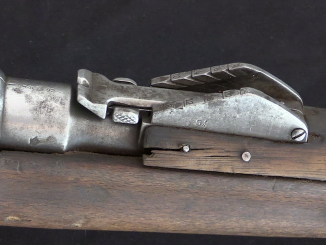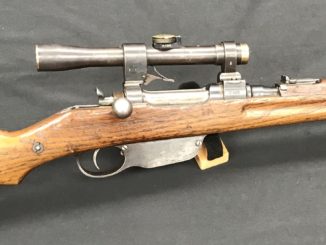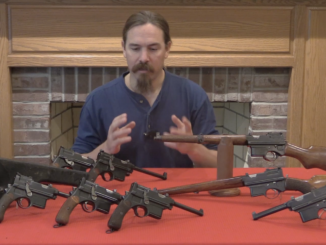What was the first true semiautomatic pistol? Let’s take a look…
Before there were self-loading pistols, there were manually operated repeating pistols with magazines – like the 1850s Volcanics. A surprising number of this type of pistol were developed in Austria in the 1880s, and they led directly to some of the first blowback automatic pistols, like the Laumann and Schonberger-Laumann. However, there was also some early guns designed from the ground up as semiautos, like the Dormus. The C93 Borchardt is agreed to be the first commercially successful pistol, but what other designs came first that were functional but not successful?




Oh Ian, you’re such a tease. But that’s okay, I’ll bite. Just what is that pistol in the first row, far right, (From the viewers perspective.)? And is that what we’d today call a DA/SA trigger on it?
Looks like a blow-forward Mannlicher, similar to this video:
https://www.forgottenweapons.com/6-5mm-mannlicher-1894-at-james-d-julia/
It sure does. Thanks!
It is a Mannlicher Mod94 – I have number 68
Well, the July patent does look rather dubious, with that screw-delay mechanism – the November patent seems more likely to be functional, so 4 days is probably more correct-ish.
😉
“patent”
If we sort via patent date, then we shouldn’t overlook Clair automatic pistol:
https://www.forgottenweapons.com/clair-automatic-pistol/
with first patent dating 1889
http://fastmarksman.ru/clair1.htm
states that Clair brothers start works in field of automatic weapons development in 1880 and tried got British patent in 1889, but failed, as it was actually patented earlier.
But as Ian points out here;
https://www.forgottenweapons.com/clair-automatic-pistol/
The Clair pistol prototype was not made until 1893. After the Laumann and Schonberger-Laumann prototypes, and just before the Borchardt.
So while they were in the first heat, the Clair brothers didn’t get the pole position.
cheers
eon
Some information about Salvator from Salvator-Dormus from https://de.wikipedia.org/wiki/Karl_Salvator_von_Österreich-Toskana
Karl Salvator (1839-1892) was Erherzog of Austria and prince of Tuscany (now part of Italy), Feldmarschalllieutenant, weapon designer and constructor, also active in field of hydrotechnic and architecture. Full name Karl Salvator Maria Joseph Johann Baptist Philipp Jakob Januarius Ludwig von Österreich-Toscana, son of Leopold II of Tuscany and Princess Maria Antonia of the Two Sicilies, place of birth: Florence.
Military service: 1857: Major, 1859: Oberstleutnant, 1860: Oberstinhaber, 1876: Generalmajor, 1886: Feldmarschalleutnant
Fire-arms invention: co-developed machine-gun with Dormus which was produced by Škoda Pilsen factory and used in fortifications ( Mitrailleuse M.93) and automatic pistol also co-developed with Dormus (Repetierpistole System Carl Salvator und Georg Ritter von Dormus) but Salvator died before development ended.
Some information about Georg von Dormus from https://de.wikipedia.org/wiki/Georg_von_Dormus
Georg Ritter von Dormus (1853-1940) was Ritter. He was born in officer’s family.
Military service: 1871: Leutnant, 1877: Oberleutnant, 1882: Hauptmann, 1893: Major, 1895: Oberstleutnant, 1905: Generalmajor, 1912: Feldmarschalleutnant
Notice that both (Erzherzog Salvator and Ritter von Dormus) have some noble title.
I wonder if any repeating flintlock pistols were self-cocking/loading, and if so, would that have qualified any as a bona fide automatic pistol — or would the definition of that term only apply to the more modern fixed-cartridge guns?
I was thinking of perhaps something along the lines of a blowback/gas/recoil operated Lorenzonis flintlock — https://www.youtube.com/watch?v=UyBPaXbp7Qg — or is there some reason why such a design could not possibly have been implimented?
oops, pardon my spelling 🙁
I forgot to remember that 18th century and earlier guns — pre-industrial revolution — were often made to order one at a time by a skilled craftsman, and as such might not have had patents, serial numbers, or other documentation.
aa,
In regards to when patents got started, here’s a place to start your research:
https://en.wikipedia.org/wiki/History_of_patent_law
So, quite a while ago. ^__^
One of the interesting things about early British patent law: For a while there you weren’t allowed to register a British patent if you had one already in another country, so folks would often register for a British patent first. (This also made for a nice consistent cash flow in the British patent system. ^__^) I really do wish that the UK would get all their patents scanned and published to the internet!
“could not possibly have been implimented”
Speaking generally: lack of cartridge case,
in cartridge-feed self-loading or machine gun when breech is in process of opening case prevents hot-gas going out that side, in case of cartridge-less gases will go out immediately, so there is need for time space between shot fired and delivery of new powder.
good point – a self-loading delay mechanism of some kind would be essential in a loose-gunpowder pistol, and hopefully there are no glowing embers left in the chamber/barrel when the next powder load is chambered.
В.Е. Маркевич (Ручное огнестрельное оружие) lists some automatic pistol earlier to Salvator-Dormus, according to him first was american Luce automatic pistol from 1874, see image here: http://forum.guns.ru/forum_light_message/36/392536.html
in post from 06-12-2008 22:50
I found some description of Salvator-Dormus:
http://www.manebooks.com/firearms/dormus.htm
Notice that it looks well-tought in area of user-friendly, especially when compared to same-era (1890s) automatic pistols, non-moving sights should have good effect on accuracy (compare to MCM (Margolin) automatic pistol), magazine in grips allows good barrel-length-to-overall-length-ratio, combined safety/sliderelease lever
(some addendum to info about Erherzog Salvator: he was also active hunter and has collection of hunting weapons, which might explain it – as he was not only inventor but also user)
Thanks for showing the page, I also like this pistol. It looks exceptionally well ‘cultured’ for the time period. I also noticed for how much it was sold.
“surprising number of this type of pistol were developed in Austria in the 1880s”
You Press the Button, We Do the Rest (used for photography advert in 1888) is good summary of spirit of that times.
https://en.wikipedia.org/wiki/You_Press_the_Button,_We_Do_the_Rest
Daweo,
Except that you had to mail your Kodak back to the factory to get it reloaded. ^__^
On the plus side, you had 100 exposures before you needed to reload.
On the minus side, you had to get through 100 exposures before you could see your pictures. ^__^
Daweo,
Kodak No. 1:
http://camera-wiki.org/wiki/Kodak_No._1
Besides birthing the first (semi)automatic pistols, that part of the world (Austria & Germany) was also renowned at the time for producing the world’s highest quality cameras and optics — a title held basically to the present day. (Kodaks, in contrast, were barely better than a pinhole camera)
This reminds me about how bad of an “investment” film cameras turned out to be once the digital age struck. While some of the top-end professional-grade cameras such as Leica and Hasselblad (which offers digital conversion adapters) have held value somewhat, those in the next tier down have become nearly worthless. Which is of course fantastic for anyone today wanting to start a collection of classic German or Japanese film cameras … assuming that such people might actually still exist in the world.
I’d imagine that the exact same thing might happen if and when future guns “go digital” and shoot photon rays or whatever else, and old-fashioned brass ammunition stops being made.
aa,
https://en.wikipedia.org/wiki/Schott_AG#History
“Zeiss” is one of those magic words. ^__^
Slugthrowers will probably always be with us, because there will always be an application where an energy-based weapon either can’t be used or can’t be brought in undetected. See The Honor of the Queen by David Weber.
Also, just as not every pioneer could afford a Winchester, not every colonist will be able to afford a gaussrifle.
Expect the Mauser 98, in some version or another, to be a standard piece of “sodbuster” equipment, even halfway across the galaxy.
It comes in handy in case the three-meter, sixteen-hundred kilogram Zarathustran damnthing doesn’t respond to “nice kitty”.
cheers
eon
“gaussrifle”
It isn’t also Slugthrower? https://en.wikipedia.org/wiki/Coilgun states that Gauss rifle launch projectiles.
“not every pioneer could afford a Winchester, not every colonist”
Also notice that energy container might be unavailable/hard to get in some places. Similarly to metallic-case ammunition, which elongated life of percussion weapons in such places.
“The Honor of the Queen by David Weber”
So called Bolter are used in universe of Warhammer 40k table-top game.
http://wh40k.lexicanum.com/wiki/Boltgun
Which fire rocket-propelled projectile.
I was actually thinking more of Honor’s 1911 Colt .45 automatic- which could be smuggled past weapons sensors that triggered on energy emissions from thing like the battery packs in grav pulsers. A 1911 has no such pack unless it has laser sights, etc.
Also, technically, a railgun is defined as an energy-type weapon, because it operates electromagnetically and thus requires a power source. While it fires a solid projectile, it has an energy signature, and actually a pretty noticeable one.
Yes, this is why the railgun on the new Zumwalt>/em> class “stealth” destroyer sort of makes nonsense of the ship’s low-RCS engineering. However radar-invisible it is, when that electromagnetic cannon fires the ship has an EM footprint the size of Chicago.
cheers
eon
It would just stick around because it’s simple to make. The sharp rock of 3.4 million years ago is still in use today as the knife. By the time energy weapons, the so-called next step of weapon evolution, get in the field, you can still easily make explosive-based weapons. That technology is 200 years old.
Rather than energy weapons, which I don’t think would ever develop, I think we would have automated self-sustaining, self-targeting drones from a continent away.
Very good subject and excellent presentation, as usual at FW.